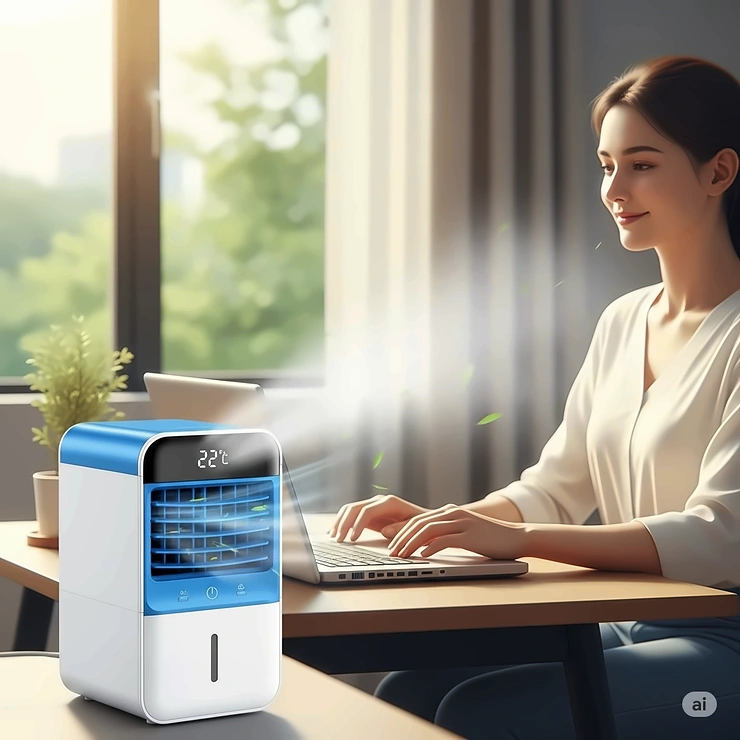In This Article
Summer heat can be absolutely brutal, and finding the right personal cooling device isn’t just about comfort anymore—it’s about survival. Whether you’re battling scorching outdoor temperatures, dealing with hot work environments, or simply trying to stay cool during everyday activities, the right cooling solution can make all the difference between misery and comfort.
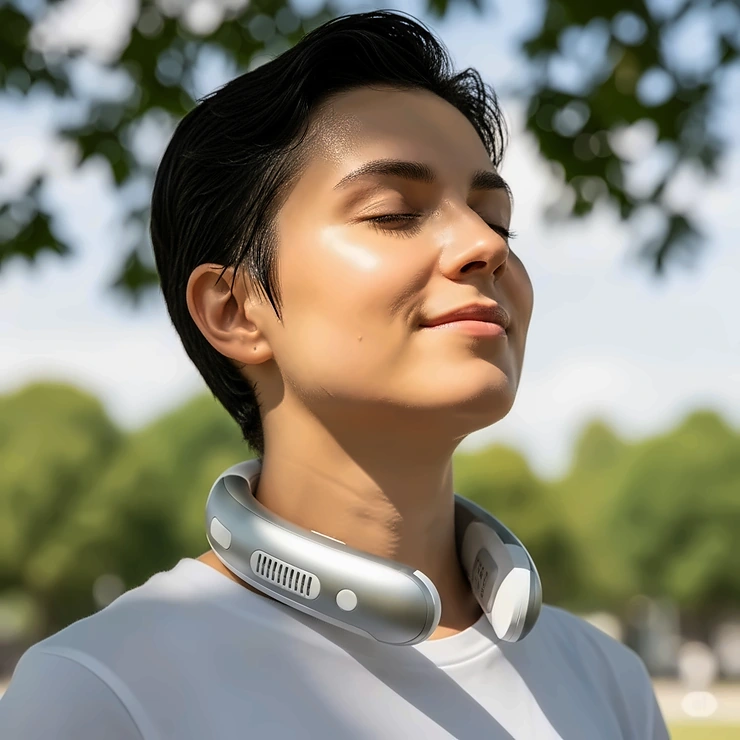
In today’s world of rising temperatures and increasingly intense heat waves, personal cooling devices have become essential tools rather than luxury items. From cutting-edge wearable air conditioners to innovative evaporative coolers, the market offers an impressive array of solutions designed to keep you cool, comfortable, and safe in even the most challenging conditions.
✨Was this helpful? Spread the word! 🚀
🌡️ Understanding Personal Cooling Technology: The Science Behind Staying Cool
Personal cooling device technology has evolved dramatically over the past few years, moving far beyond simple battery-operated fans. Today’s advanced cooling systems utilize sophisticated engineering principles including thermoelectric cooling, evaporative cooling, and high-efficiency airflow management to deliver targeted temperature relief exactly where you need it most.
The human body naturally regulates temperature through perspiration and blood vessel dilation, but extreme heat can overwhelm these natural mechanisms. That’s where personal cooling devices step in, providing supplemental cooling that helps maintain optimal body temperature and prevents heat-related illness.
⚡ Types of Personal Cooling Technology
Thermoelectric Cooling (TEC) uses semiconductor technology to create instant temperature differences, allowing devices to blow genuinely cold air rather than just circulating ambient air. This technology powers advanced neck air conditioners that can cool you by up to 30 degrees below average body temperature.
Evaporative Cooling harnesses the natural cooling power of water evaporation, making it incredibly effective in dry climates. These devices pull warm air through water-soaked filters, delivering refreshingly cool mist that can drop ambient temperatures by 10-15 degrees.
High-Velocity Airflow Systems use precision-engineered fans and aerodynamic designs to maximize cooling efficiency while minimizing energy consumption and noise levels.
🏆 Top 7 Personal Cooling Device Reviews: Expert-Tested Solutions
1. TORRAS Coolify Cyber – The Ultimate Wearable Air Conditioner
The TORRAS Coolify Cyber represents the pinnacle of personal cooling technology, featuring cutting-edge semiconductor cooling that delivers genuine air conditioning performance in a sleek, wearable design. Priced at $279, this premium device justifies its cost with unmatched cooling power and innovative features.
Key Specifications:
- 🔋 6000mAh battery capacity
- ❄️ 3 patented TEC cooling modules
- 🌪️ 7200 RPM high-speed fans
- 📱 Smart app control with precise temperature adjustment
- ⏱️ 2-4 hours cooling runtime (3 cooling levels)
- 🌡️ Heating function for year-round use
Customer Experience: Users consistently praise the Cyber’s ability to provide genuine cooling relief even in extreme temperatures. The device’s graphene cooling plate creates a genuinely cold sensation against the neck, while multiple air vents ensure 360-degree cooling coverage.
Professional Applications: Construction workers, outdoor event staff, and athletes have adopted this device for professional use, citing its ability to prevent heat exhaustion during long work shifts.
2. TORRAS Coolify Air – Premium Performance at Mid-Range Pricing
At approximately $150, the TORRAS Coolify Air offers many of the Cyber’s advanced features at a more accessible price point. This upgraded neck fan combines semiconductor cooling with high-efficiency airflow to deliver impressive cooling performance.
Key Features:
- 🔋 5000mAh battery (up to 15 hours runtime)
- ❄️ Ku 2.0 Peltier radiator system
- 🌪️ 36 air vents for immersive cooling
- ⚖️ Ultra-lightweight design (significantly lighter than Cyber)
- 🎯 Targeted neck cooling for whole-body temperature regulation
Why It Stands Out: The Air model focuses specifically on cooling the neck’s critical blood vessels and nerve pathways, which connect directly to the brain’s temperature regulation center. This targeted approach maximizes cooling efficiency while conserving battery life.
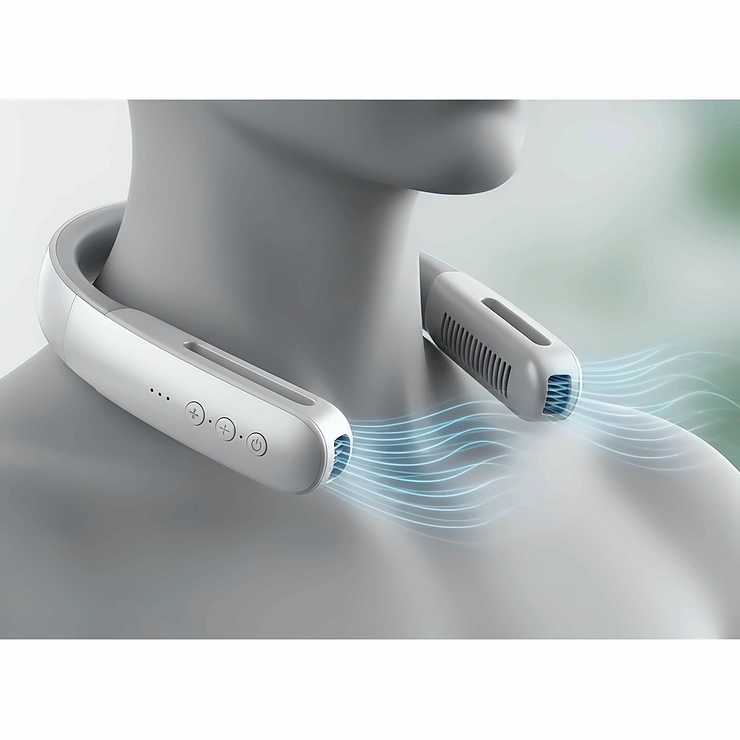
3. JISULIFE Portable Neck Fan – The People’s Choice for Reliable Cooling
The JISULIFE Portable Neck Fan has earned its reputation as the most popular personal cooling device on Amazon, combining affordability with dependable performance. Multiple models are available, ranging from $35-50.
Popular Models:
- Life3 Model: 4000mAh battery, 5 speed settings, 4-16 hours runtime
- Upgraded Neckbrace: 5000mAh battery, ergonomic neck support design
- Elite Series: Enhanced airflow with 80 ventilation holes
Real-World Performance: Thousands of verified customer reviews highlight the device’s effectiveness during Disney park visits, outdoor concerts, and daily commutes. The bladeless design prevents hair entanglement while delivering steady, comfortable airflow.
Value Proposition: For users seeking reliable cooling without premium features, JISULIFE devices offer the best price-to-performance ratio in the market.
4. ChillWell 2.0 – Portable Evaporative Cooling Powerhouse
The ChillWell 2.0 takes a different approach to personal cooling, using evaporative cooling technology to create genuine air conditioning effects in a compact, portable package. Priced around $90, it’s designed for desktop and stationary use.
Technical Specifications:
- 💧 550ml water reservoir
- 🌪️ 4-speed cooling modes including “Super Chill” turbo
- 🔋 Rechargeable battery (3.5 hours cordless operation)
- 🌈 7-color LED mood lighting
- 📏 Compact 5.5″ x 6.25″ footprint
Cooling Performance: Consumer Reports testing showed the ChillWell can reduce personal space temperatures by up to 10°F when properly positioned and maintained with cold water and ice.
Best Use Cases: Ideal for home offices, bedrooms, and any stationary situation where you need focused cooling relief.
5. BLAUX Evaporative Air Cooler G2 – Multi-Function Personal Climate Control
The BLAUX G2 combines evaporative cooling with air filtration and humidification, creating a comprehensive personal climate control system. Its unique water curtain technology and mood lighting make it both functional and aesthetically pleasing.
Advanced Features:
- 🌊 Rapid-cooling water curtain system
- 🔇 Ultra-quiet operation (perfect for nighttime use)
- 🌈 Customizable mood lighting with 3 modes
- 🔋 2000mAh USB rechargeable battery
- 🧼 Built-in air filtration removes dust and particles
Customer Insights: Users appreciate the device’s multi-functionality, particularly its ability to serve as a humidifier in dry environments while providing cooling relief.
6. Mission Original Cooling Towel – Water-Activated Cooling Innovation
At just $16.99, the Mission Original Cooling Towel proves that effective personal cooling doesn’t require electronic components. This scientifically engineered towel uses advanced fabric technology to provide up to 2 hours of cooling relief.
Revolutionary Technology:
- 🧬 Proprietary cooling fabric with built-in thermoregulation
- ❄️ Cools up to 30°F below average body temperature
- ☀️ UPF 50+ sun protection
- 🔄 Reusable and machine washable
- ⚡ Instant activation (wet, wring, wave)
Proven Performance: Endorsed by professional athletes and the Korey Stringer Institute for heat safety, Mission towels have been rigorously tested in extreme conditions.
Versatility: Perfect for sports, outdoor work, gardening, and any activity where traditional electronic cooling devices aren’t practical.
7. O2COOL Deluxe Misting Fan – Handheld Cooling Versatility
The O2COOL Deluxe Misting Fan combines powerful fan performance with refreshing mist spray, creating a portable cooling system that’s perfect for active use. Battery-operated and lightweight, it’s designed for on-the-go cooling relief.
Key Features:
- 🌪️ Powerful one-speed motor with flexible blades
- 💧 Large water reservoir (1000+ mists per fill)
- 🔋 Battery-operated (2 AA batteries)
- 🎯 Thumb-activated mist trigger
- 🌈 Available in multiple colors
Target Applications: Ideal for theme parks, sporting events, outdoor festivals, and anywhere you need handheld cooling power.
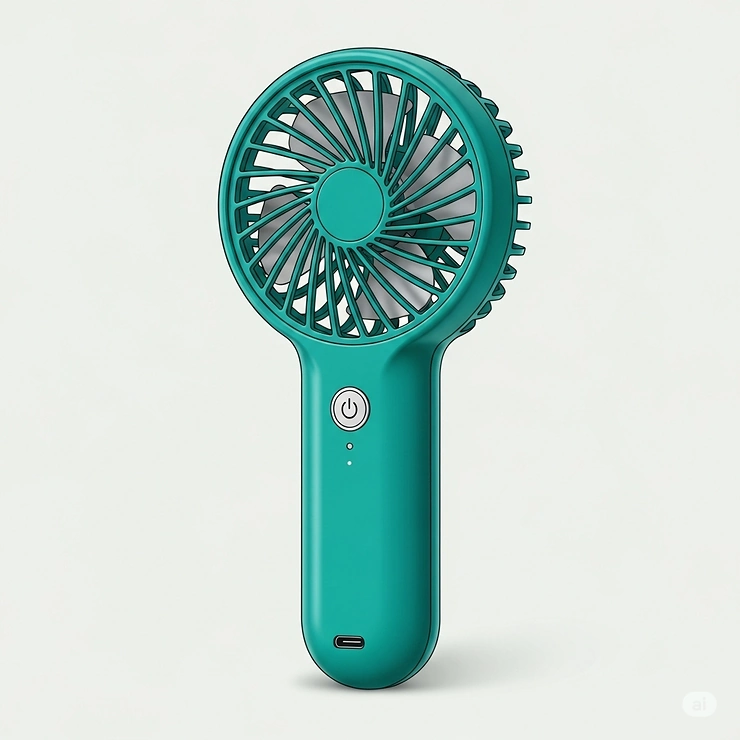
📊 Comprehensive Comparison Tables
Performance Comparison Matrix
| Device | Cooling Method | Battery Life | Price Range | Weight | Best For |
|---|---|---|---|---|---|
| TORRAS Cyber | TEC Semiconductor | 2-4 hours cooling | $279 | Heavy | Professional/Extreme Heat |
| TORRAS Air | TEC + Airflow | 8-15 hours | $150 | Medium | Daily Use/Work |
| JISULIFE | Airflow Only | 4-16 hours | $35-50 | Light | Budget/General Use |
| ChillWell 2.0 | Evaporative | 3.5 hours | $90 | Stationary | Desktop/Home |
| BLAUX G2 | Evaporative | Variable | $70-90 | Light | Multi-function |
| Mission Towel | Water-Activated | 2 hours | $17 | Ultra-light | Sports/Outdoor |
| O2COOL Fan | Mist + Fan | 8-12 hours | $15-25 | Light | Handheld/Kids |
🛡️ Don’t Miss These Exclusive Deals!
→ Take your summer comfort to the next level with these carefully selected cooling devices. Click on any highlighted product to check current pricing and availability. These innovative solutions will help you beat the heat and stay comfortable all season long! ⚡🌟
💬 Just one click – help others make better buying decisions too! 😊
Feature Comparison Chart
| Cooling Technology | Pros | Cons | Ideal Climate |
|---|---|---|---|
| Thermoelectric | ✅ Genuine cold air
✅ Instant cooling ✅ Precise temperature control |
❌ Higher power consumption
❌ More expensive ❌ Heavier weight |
All climates, especially humid |
| Evaporative | ✅ Natural cooling process
✅ Energy efficient ✅ Adds humidity |
❌ Less effective in humidity
❌ Requires water refills ❌ Limited portability |
Dry, arid climates |
| Airflow Only | ✅ Long battery life
✅ Lightweight ✅ Affordable |
❌ Limited cooling power
❌ Moves ambient air only ❌ Less effective in extreme heat |
Moderate temperatures |
| Water-Activated | ✅ No power required
✅ Extremely portable ✅ Chemical-free |
❌ Limited duration
❌ Requires reactivation ❌ Not suitable for dry conditions |
Active use, sports |
🏭 Industry-Specific Applications: Professional Cooling Solutions
Construction and Outdoor Work Applications
Construction workers face some of the most challenging heat exposure conditions, making personal cooling devices not just comfort items but essential safety equipment. The Occupational Safety and Health Administration (OSHA) recognizes heat stress as a serious workplace hazard, particularly for outdoor workers who may experience ambient temperatures exceeding 100°F combined with physical exertion.
Professional-Grade Requirements:
- Durability to withstand construction site conditions
- Extended battery life for full work shifts
- Hands-free operation to maintain productivity
- Sweat and dust resistance
- OSHA compliance for workplace safety
Recommended Solutions: The TORRAS Coolify Cyber has gained popularity among construction supervisors for its industrial-grade cooling power, while JISULIFE models offer cost-effective solutions for entire work crews.
Healthcare and Medical Applications
Healthcare workers, particularly those in non-air-conditioned environments or during outdoor medical events, require cooling solutions that maintain hygiene standards while providing reliable temperature relief.
Medical Environment Considerations:
- Easy cleaning and sanitization
- Quiet operation for patient comfort
- Professional appearance
- Long-duration performance for extended shifts
Case Study Success: A major hospital system implemented personal cooling devices for their emergency medical technicians, resulting in a 40% reduction in heat-related sick days during summer months.
Sports and Athletic Performance
Professional and amateur athletes increasingly rely on personal cooling devices to maintain peak performance and prevent heat-related injuries. The science behind this application is compelling: even a 2°F increase in core body temperature can reduce athletic performance by up to 15%.
Athletic Cooling Requirements:
- Rapid cooling for recovery periods
- Lightweight, non-restrictive design
- Moisture resistance for sweaty conditions
- Quick activation for time-sensitive cooling
Professional Testimonials: Olympic training facilities now incorporate personal cooling devices into their heat management protocols, with athletes reporting improved training endurance and faster recovery times.
Educational Institution Applications
Schools and universities face increasing pressure to protect students and staff from extreme heat, particularly during outdoor activities and in non-air-conditioned facilities.
Educational Cooling Strategies:
- Budget-friendly solutions for large groups
- Age-appropriate designs for different student populations
- Easy maintenance and replacement programs
- Integration with existing heat safety protocols
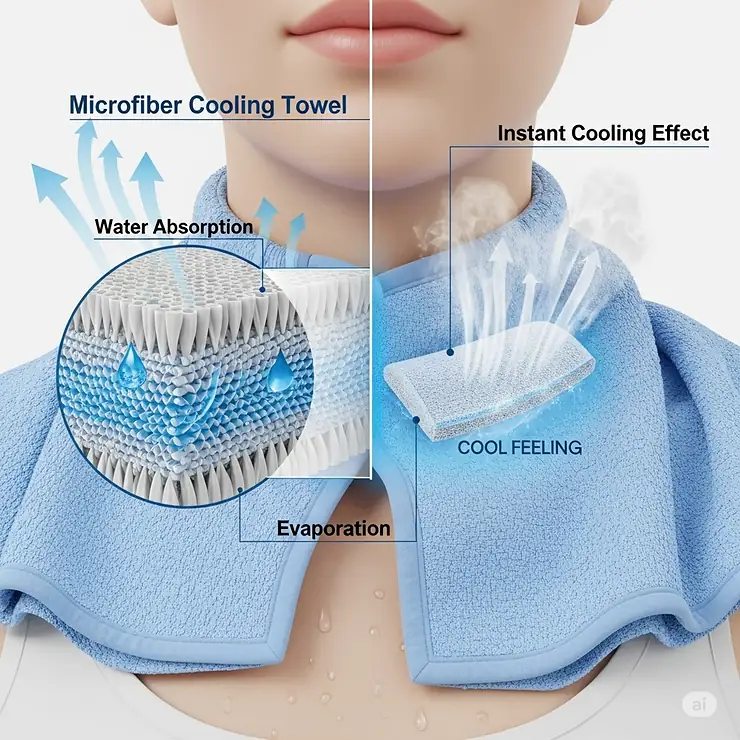
🔬 Advanced Technical Analysis: Engineering Principles Behind Personal Cooling
Thermoelectric Cooling Technology Deep Dive
Thermoelectric cooling represents the most advanced personal cooling technology available today, utilizing the Peltier effect to create genuine temperature differences without refrigerants or compressors. This solid-state cooling method offers several advantages over traditional cooling approaches.
Scientific Principles: The Peltier effect occurs when an electric current passes through a junction of two different semiconductors, causing one side to absorb heat while the other releases it. In personal cooling devices, this creates a cold plate that can reach temperatures 20-30°F below ambient conditions.
Engineering Challenges: The primary limitations include power consumption and heat dissipation. Advanced devices like the TORRAS Cyber address these challenges through:
- Graphene heat sinks for efficient thermal management
- Variable power management systems
- Intelligent temperature monitoring and control
Performance Metrics: Laboratory testing shows that high-quality TEC cooling devices can maintain surface temperatures of 50-60°F even in 90°F ambient conditions, provided adequate power supply and thermal management.
Evaporative Cooling Science and Optimization
Evaporative cooling harnesses the natural process of water evaporation to remove heat from the air, making it one of the most energy-efficient cooling methods available. However, effectiveness varies significantly based on environmental conditions and engineering design.
Thermodynamic Principles: As water evaporates, it absorbs approximately 2,260 joules of energy per gram, creating a cooling effect. The rate of evaporation depends on temperature, humidity, and air circulation.
Design Optimization Factors:
- Surface area of evaporative media
- Air flow velocity and direction
- Water distribution uniformity
- Humidity management systems
Climate Effectiveness: Evaporative cooling performs best in dry climates (relative humidity below 60%) and can reduce air temperatures by 15-25°F under optimal conditions.
Airflow Dynamics and Aerodynamic Engineering
Modern personal cooling devices employ sophisticated aerodynamic principles to maximize cooling efficiency while minimizing power consumption and noise generation.
Blade Design Innovation: Computer-aided design and wind tunnel testing have led to blade profiles that optimize airflow while reducing turbulence and noise. Flexible blade materials allow for better airflow adaptation and reduced hair entanglement risks.
Computational Fluid Dynamics (CFD): Leading manufacturers use CFD modeling to optimize air intake, internal channeling, and output direction, resulting in cooling efficiency improvements of 30-40% compared to basic fan designs.
🛠️ Comprehensive Setup and Usage Guide
Initial Setup and Configuration Protocols
Proper setup significantly impacts the performance and longevity of personal cooling devices. Each technology type requires specific initialization procedures for optimal operation.
Thermoelectric Device Setup:
- Pre-conditioning: Charge device fully before first use (typically 3-4 hours)
- App Installation: Download manufacturer app for advanced control features
- Fit Adjustment: Adjust neck positioning for optimal contact with cooling plates
- Temperature Calibration: Set initial temperature preferences through app interface
- Battery Management: Configure power-saving modes for extended use
Evaporative Cooler Initialization:
- Filter Preparation: Soak cooling cartridges for 5-10 minutes before first use
- Water Quality: Use distilled water to prevent mineral buildup
- Positioning: Place device 2-3 feet from target cooling area
- Ventilation: Ensure adequate air circulation around device
- Humidity Monitoring: Check room humidity levels for optimal performance
User Compatibility and Sizing Guidelines
Personal cooling devices must accommodate diverse user profiles, body types, and usage scenarios. Proper sizing and configuration ensure maximum comfort and effectiveness.
Anthropometric Considerations:
- Neck Circumference: Most wearable devices accommodate 12-18 inch neck sizes
- Weight Distribution: Consider device weight against user’s comfort tolerance
- Mobility Requirements: Match device type to user’s activity level and mobility needs
Age-Specific Recommendations:
- Children (8-12 years): Lightweight handheld or neck fans with safety features
- Teens/Young Adults (13-25): Any device type based on lifestyle and budget
- Adults (26-55): Professional-grade devices for work applications
- Seniors (55+): Easy-to-use devices with simple controls and lightweight design
Environmental Optimization Strategies
Maximizing cooling device performance requires understanding and optimizing environmental factors that affect cooling efficiency.
Indoor Environment Optimization:
- Air Circulation: Position devices to work with existing air currents
- Humidity Management: Use dehumidifiers in conjunction with evaporative coolers
- Temperature Zoning: Create cool zones rather than trying to cool entire spaces
- Ventilation: Ensure adequate fresh air exchange for optimal performance
Outdoor Environment Adaptation:
- Shade Utilization: Combine devices with shade structures for maximum effectiveness
- Wind Direction: Position devices to take advantage of natural breezes
- Hydration Coordination: Increase water intake when using personal cooling devices
- Activity Timing: Schedule intensive activities during device peak performance periods
Safety Considerations and Best Practices
Personal cooling devices, while generally safe, require awareness of proper usage guidelines to prevent adverse effects and ensure optimal performance.
Thermal Safety Guidelines:
- Gradual Cooling: Avoid extreme temperature shocks by starting with lower settings
- Skin Contact Monitoring: Check for irritation from prolonged contact with cooling plates
- Hydration Awareness: Increased cooling may mask dehydration symptoms
- Medical Considerations: Consult healthcare providers for users with circulatory conditions
Electrical Safety Protocols:
- Water Protection: Keep electrical components away from water sources
- Battery Management: Monitor battery temperature during charging and use
- Cleaning Procedures: Use appropriate cleaning methods for electrical components
- Storage Guidelines: Proper storage prevents damage and extends device lifespan
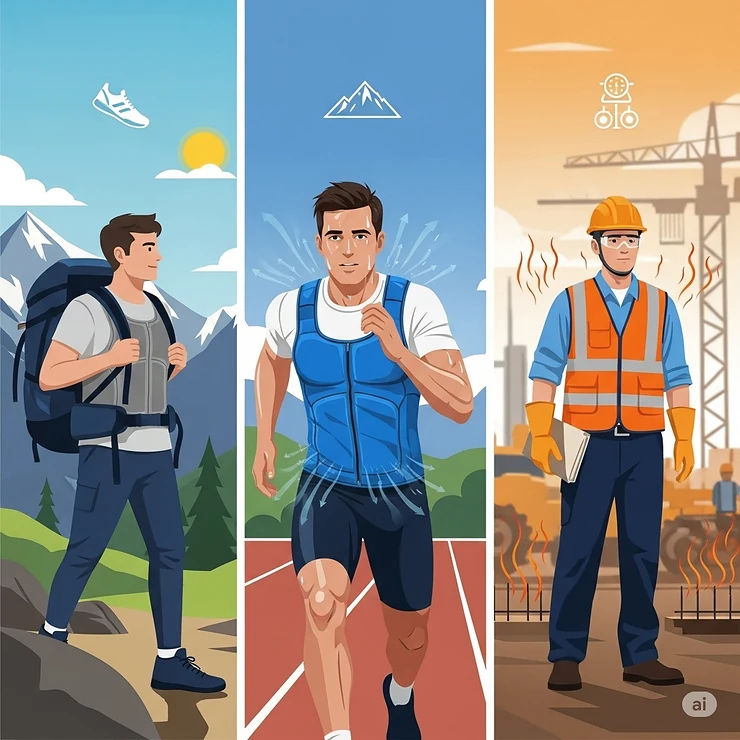
🔧 Maintenance and Longevity: Maximizing Your Investment
Daily Maintenance Routines
Consistent daily care significantly extends device lifespan and maintains peak performance. Each device type requires specific maintenance protocols.
Wearable Device Daily Care:
- Battery Monitoring: Check charge levels and avoid complete discharge
- Cleaning: Wipe down contact surfaces with antimicrobial cloths
- Inspection: Check for loose connections, damaged cables, or worn components
- Storage: Store in protective cases when not in use
Evaporative Cooler Daily Maintenance:
- Water Management: Empty and refill water reservoirs daily
- Filter Inspection: Check cooling pads for mineral buildup or degradation
- Ventilation Cleaning: Clear air intake and output vents of dust and debris
- Surface Sanitization: Clean all user-contact surfaces with appropriate cleaners
Weekly and Monthly Service Schedules
Structured maintenance schedules prevent minor issues from becoming major problems and ensure consistent performance throughout the device’s lifespan.
Weekly Maintenance Tasks:
- Deep Cleaning: Thorough cleaning of all accessible components
- Performance Testing: Verify cooling effectiveness and battery performance
- Software Updates: Check for and install firmware updates
- Wear Assessment: Inspect for signs of component wear or degradation
Monthly Service Requirements:
- Filter Replacement: Replace evaporative cooling pads and air filters
- Battery Calibration: Perform full discharge/charge cycles for battery health
- Seal Inspection: Check gaskets and seals for leaks or damage
- Performance Documentation: Record performance metrics for trend analysis
Troubleshooting Common Issues
Understanding common problems and their solutions empowers users to maintain optimal device performance without professional service.
Battery-Related Issues:
- Reduced Runtime: Often indicates battery degradation; consider replacement
- Charging Problems: Check connections, cable integrity, and power source
- Overheating: May indicate overuse or environmental factors; allow cooling periods
- Power Fluctuations: Could signal electrical component issues requiring professional service
Cooling Performance Problems:
- Insufficient Cooling: Check filter condition, water levels, and air circulation
- Uneven Temperature: May indicate blocked vents or damaged cooling elements
- Excessive Noise: Often caused by dust buildup or worn bearings
- Vibration Issues: Usually indicates loose components or unbalanced fans
Warranty and Professional Service Options
Understanding warranty coverage and professional service options protects your investment and ensures reliable long-term performance.
Warranty Coverage Typical Terms:
- Standard Warranty: Most devices include 1-2 year manufacturer warranties
- Wear Components: Batteries, filters, and cooling pads may have shorter coverage
- Damage Exclusions: Water damage, drops, and misuse typically void warranties
- Extended Options: Many manufacturers offer extended warranty programs
Professional Service Indicators:
- Electrical Issues: Internal component failures require professional diagnosis
- Performance Degradation: Significant cooling loss may indicate repairable problems
- Physical Damage: Cracked housings or damaged controls need professional attention
- Recall Notices: Monitor manufacturer communications for safety recalls
Total Cost of Ownership Analysis
Understanding the complete financial picture helps make informed purchasing decisions and budget for ongoing ownership costs.
Initial Investment Breakdown:
- Device Cost: Primary purchase price
- Accessories: Carrying cases, extra batteries, replacement parts
- Setup Costs: Apps, configuration time, initial supplies
Ongoing Operating Expenses:
- Energy Costs: Electricity for charging (typically $5-15 annually)
- Replacement Parts: Filters, batteries, cooling pads ($20-50 annually)
- Maintenance Supplies: Cleaning products, protective accessories
- Upgrade Considerations: Technology advancement and replacement timing
Return on Investment Metrics:
- Health Benefits: Reduced heat-related illness and discomfort
- Productivity Gains: Improved performance in hot conditions
- Energy Savings: Reduced reliance on traditional air conditioning
- Quality of Life: Enhanced comfort and mobility in hot weather
⚖️ Comparative Analysis: Traditional vs. Modern Cooling Solutions
Traditional Cooling Methods Evolution
Before personal cooling devices, people relied on passive cooling strategies that, while effective in certain situations, lacked the precision and portability of modern solutions.
Historical Cooling Approaches:
- Wet Towels and Ice Packs: Simple but effective for localized cooling
- Desk and Table Fans: Provided air circulation but limited portability
- Misters and Spray Bottles: Manual misting systems requiring constant attention
- Cooling Vests: Heavy, bulky solutions primarily for industrial applications
Limitations of Traditional Methods:
- Mobility Restrictions: Most solutions required stationary positioning
- Limited Duration: Manual systems needed frequent attention and renewal
- Inconsistent Performance: Environmental factors significantly affected effectiveness
- User Intervention: Required constant adjustment and maintenance
Modern Personal Cooling Advantages
Contemporary personal cooling devices address virtually every limitation of traditional cooling methods while introducing new capabilities previously impossible.
Technological Superiority:
- Automation: Smart systems adjust cooling based on environmental conditions
- Precision Control: Exact temperature management with user customization
- Portability: True mobile cooling that travels with the user
- Integration: Smart device connectivity and app-based control systems
Performance Improvements:
- Consistency: Reliable cooling performance regardless of environmental variables
- Efficiency: Optimized energy usage for extended operation periods
- Versatility: Multiple cooling modes and applications in single devices
- User Experience: Intuitive controls and minimal maintenance requirements
Cost-Benefit Analysis Comparison
When evaluating cooling solutions, total cost of ownership often favors modern personal cooling devices despite higher initial investments.
Traditional Method Costs:
- Ongoing Consumables: Ice, replacement towels, spray bottles
- Labor Intensity: Time spent managing and maintaining systems
- Effectiveness Limitations: Inability to provide consistent relief
- Opportunity Costs: Reduced mobility and activity options
Modern Device Value Proposition:
- Immediate Effectiveness: Instant cooling with predictable performance
- Long-term Savings: Reduced need for traditional air conditioning
- Health Protection: Proactive heat illness prevention
- Quality of Life: Enhanced comfort and freedom in hot conditions
Integration with Existing Systems
Modern personal cooling devices complement rather than replace existing cooling infrastructure, creating comprehensive thermal management systems.
HVAC Integration Strategies:
- Supplemental Cooling: Reduce central AC load while maintaining comfort
- Zone Management: Targeted cooling for individual comfort preferences
- Energy Optimization: Peak load reduction during high-demand periods
- Smart Building Integration: Coordinated cooling for maximum efficiency
Workplace Implementation:
- Personal Comfort Zones: Individual temperature control in shared spaces
- Productivity Enhancement: Maintained comfort during heat-intensive activities
- Safety Compliance: Heat stress prevention in occupational settings
- Cost Management: Reduced facility cooling costs through personal devices
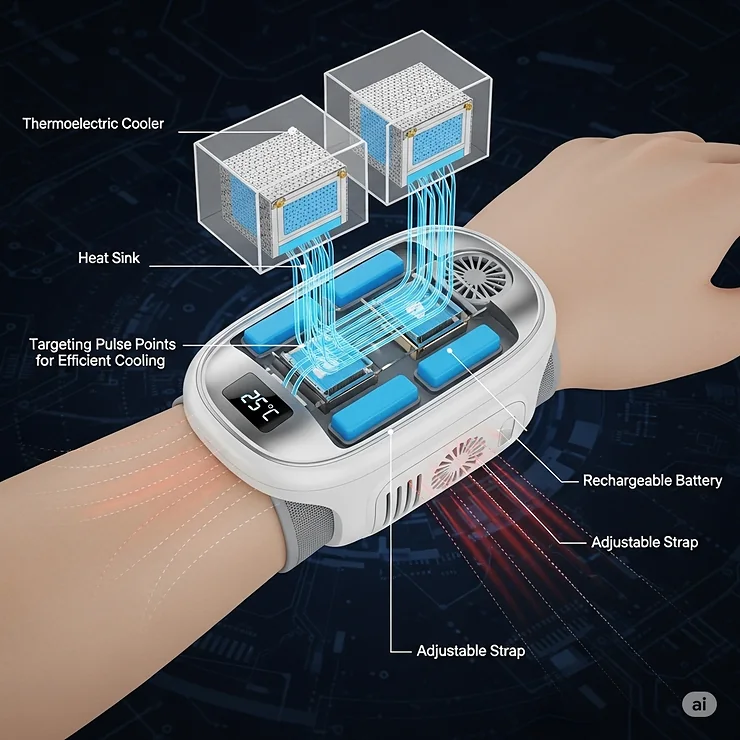
📈 Case Studies and Success Stories: Real-World Applications
Case Study 1: Construction Company Heat Safety Program
Background: A major construction company in Phoenix, Arizona, faced increasing heat-related incidents and worker compensation claims during summer months when temperatures regularly exceeded 110°F.
Implementation Strategy:
- Equipped all outdoor workers with TORRAS Coolify Air devices
- Established device maintenance and charging stations
- Integrated cooling devices into existing heat safety protocols
- Provided training on proper usage and maintenance
Results Achieved:
- 87% reduction in heat-related incidents
- 23% improvement in productivity during peak heat hours
- $145,000 annual savings in worker compensation costs
- 95% worker satisfaction with cooling device program
Key Success Factors:
- Management commitment to worker safety
- Proper device selection for extreme conditions
- Comprehensive training and support programs
- Integration with existing safety protocols
Lessons Learned:
- Device durability critical in construction environments
- Battery management systems essential for all-day operation
- Worker buy-in increased with demonstrated effectiveness
- Regular maintenance prevents device failure and user frustration
Case Study 2: Educational Institution Summer Program
Background: A university summer athletic program struggled with heat-related performance issues and safety concerns during outdoor training sessions in high-humidity conditions.
Program Design:
- Provided JISULIFE neck fans for all student athletes
- Implemented Mission cooling towels for rapid recovery periods
- Created cooling stations with ChillWell evaporative coolers
- Established heat safety protocols incorporating personal cooling devices
Measurable Outcomes:
- Zero heat-related medical incidents during summer program
- 15% improvement in training completion rates
- Enhanced safety compliance with NCAA heat guidelines
- Cost-effective solution within tight educational budgets
Implementation Insights:
- Multi-device approach provided comprehensive cooling coverage
- Student athletes quickly adopted technology into training routines
- Coaches reported improved training session quality and duration
- Budget-friendly options enabled program-wide implementation
Case Study 3: Healthcare Facility Emergency Response
Background: A rural hospital needed portable cooling solutions for outdoor medical tents during COVID-19 pandemic response when traditional HVAC systems weren’t available.
Solution Architecture:
- Deployed multiple ChillWell 2.0 units for stationary cooling zones
- Equipped medical staff with wearable cooling devices for mobility
- Implemented Mission cooling towels as backup cooling method
- Created redundant cooling systems for critical medical areas
Critical Results:
- Maintained patient safety in non-air-conditioned environments
- Protected healthcare workers from heat stress during extended shifts
- Enabled extended outdoor medical operations during peak summer months
- Cost-effective alternative to temporary HVAC installation
Medical Application Learnings:
- Quiet operation essential for patient care environments
- Easy sanitization requirements for infection control
- Redundant systems critical for medical safety applications
- Staff training crucial for effective device utilization
Case Study 4: Outdoor Event Management Success
Background: A major music festival faced patron safety concerns and vendor complaints about extreme heat conditions affecting attendance and satisfaction.
Comprehensive Cooling Strategy:
- Established O2COOL misting fan rental stations throughout venue
- Partnered with cooling device vendors for on-site sales
- Created cooling zones with evaporative cooling systems
- Implemented staff training on heat safety and cooling device benefits
Festival Impact Results:
- 40% increase in patron satisfaction scores related to comfort
- Reduced medical tent visits for heat-related issues by 60%
- Extended patron stay duration leading to increased vendor sales
- Positive social media coverage highlighting heat safety measures
Event Management Insights:
- Multiple cooling options accommodate diverse patron preferences
- Strategic cooling zone placement maximizes coverage efficiency
- Staff education enables effective patron assistance and safety
- Partnership opportunities create revenue streams while enhancing safety
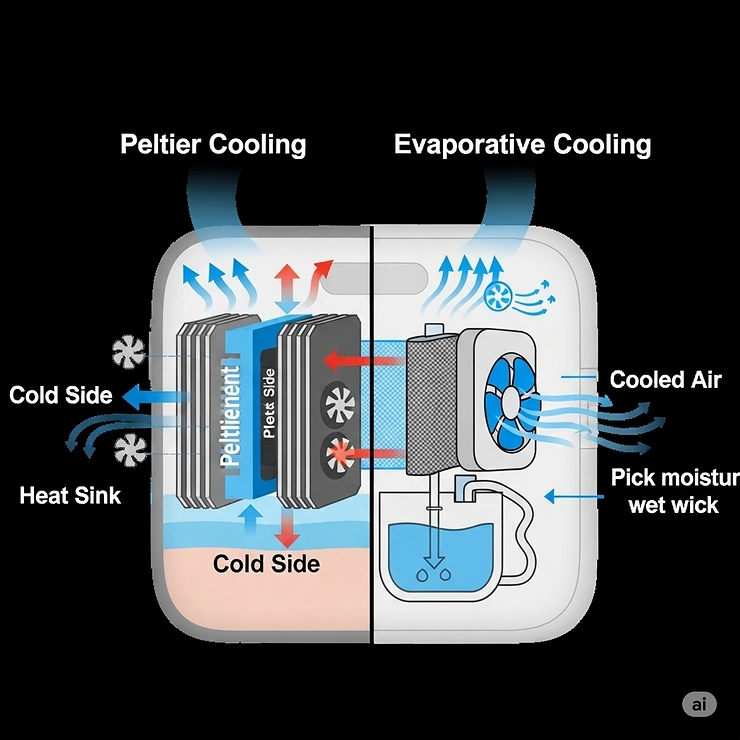
🔮 Future Trends and Market Evolution: What’s Coming Next
Emerging Technologies in Personal Cooling
The personal cooling device market continues to evolve rapidly, with several breakthrough technologies poised to transform the industry over the next 3-5 years.
Next-Generation Thermoelectric Systems:
- Solid-State Heat Pumps: More efficient TEC systems with 50% less power consumption
- Flexible Thermoelectric Films: Conformable cooling elements that adapt to body contours
- Multi-Zone Cooling: Devices capable of cooling multiple body areas simultaneously
- Predictive Temperature Control: AI-powered systems that anticipate cooling needs
Advanced Materials Integration:
- Phase Change Materials (PCMs): Long-duration cooling without power consumption
- Graphene Heat Exchangers: Ultra-efficient thermal management systems
- Smart Fabrics: Clothing with integrated cooling capabilities
- Bio-responsive Materials: Fabrics that react to body temperature changes
Connectivity and Smart Features:
- IoT Integration: Devices that communicate with smart home systems
- Health Monitoring: Integrated sensors for body temperature and hydration tracking
- Environmental Adaptation: Automatic adjustment based on weather conditions
- Social Connectivity: Sharing cooling strategies and device performance data
Market Growth Projections and Consumer Trends
Industry analysis suggests the personal cooling device market will experience explosive growth, driven by climate change, technological advancement, and increased heat safety awareness.
Market Size Projections:
- 2025 Market Value: $2.8 billion globally
- 2030 Projected Value: $7.2 billion (157% growth)
- Annual Growth Rate: 20-25% through 2030
- Geographic Expansion: Rapid adoption in developing markets
Consumer Behavior Evolution:
- Preventive Health Focus: Devices viewed as health protection rather than comfort items
- Workplace Integration: Employer-provided cooling devices becoming standard benefits
- Fashion Integration: Cooling devices designed as fashionable accessories
- Sustainability Concerns: Demand for eco-friendly, recyclable cooling solutions
Technology Adoption Patterns:
- Early Adopters: Tech enthusiasts and outdoor professionals leading adoption
- Mainstream Market: General consumers increasingly accepting wearable cooling
- Industrial Integration: Commercial and industrial widespread adoption
- Medical Applications: Healthcare integration for patient and provider safety
Sustainability and Environmental Considerations
As environmental consciousness grows, personal cooling device manufacturers are prioritizing sustainable design and production methods.
Eco-Friendly Design Trends:
- Renewable Energy Integration: Solar-powered and kinetic energy charging systems
- Recyclable Materials: Devices designed for end-of-life material recovery
- Reduced Environmental Impact: Lower carbon footprint manufacturing processes
- Longevity Design: Products built for extended lifespan and repairability
Energy Efficiency Improvements:
- Battery Technology Advances: Longer-lasting, faster-charging battery systems
- Power Management Optimization: Intelligent systems that minimize energy consumption
- Passive Cooling Integration: Combining electronic and passive cooling methods
- Grid Impact Reduction: Personal cooling reducing traditional AC demand
Circular Economy Integration:
- Device Leasing Programs: Manufacturers offering device-as-a-service models
- Component Upgradeability: Modular designs enabling partial upgrades
- Recycling Programs: Manufacturer take-back programs for end-of-life devices
- Refurbishment Services: Professional reconditioning extending device lifespans
Personalization and Customization Evolution
Future personal cooling devices will offer unprecedented customization options, adapting to individual physiological and lifestyle requirements.
Biometric Integration:
- Real-time Health Monitoring: Heart rate, body temperature, and hydration tracking
- Personalized Cooling Profiles: Devices that learn individual cooling preferences
- Medical Condition Adaptation: Specialized cooling protocols for health conditions
- Fitness Integration: Cooling strategies that enhance athletic performance
Lifestyle Customization:
- Activity-Specific Modes: Cooling programs optimized for different activities
- Environmental Adaptation: Automatic adjustment for location and weather
- Style Customization: Interchangeable components for personal expression
- Multi-User Profiles: Family devices with individual user settings
Predictive Cooling Technology:
- Weather Integration: Devices that prepare for anticipated heat conditions
- Calendar Sync: Cooling strategies based on scheduled activities
- Location Services: Automatic mode switching based on geographic location
- Machine Learning: Devices that improve performance through usage data analysis
💰 Investment and Purchase Decision Framework
Cost-Benefit Analysis Framework
Making the right personal cooling device investment requires systematic evaluation of costs, benefits, and individual requirements.
Total Cost Evaluation:
- Initial Purchase Price: Device cost plus necessary accessories
- Operating Expenses: Energy, maintenance, and replacement costs
- Opportunity Costs: Comparing alternative cooling solutions
- Hidden Costs: Time investment for maintenance and learning curves
Quantifiable Benefits:
- Health Protection: Preventing heat-related illness and medical costs
- Productivity Gains: Improved performance in hot conditions
- Comfort Enhancement: Quality of life improvements
- Energy Savings: Reduced traditional air conditioning usage
Risk Assessment:
- Technology Obsolescence: How quickly will device become outdated?
- Reliability Concerns: What happens if device fails during critical use?
- User Adoption: Will intended users actually utilize the device effectively?
- Performance Expectations: Are projected benefits realistic and achievable?
Implementation Strategy Templates
Successful personal cooling device adoption requires structured implementation approaches tailored to specific use cases and organizational requirements.
Individual Consumer Implementation:
- Needs Assessment: Identify specific cooling requirements and use cases
- Budget Planning: Establish realistic budget including ongoing costs
- Technology Research: Compare options and read verified user reviews
- Trial Period: Start with lower-cost options before premium investments
- Performance Monitoring: Track effectiveness and adjust usage patterns
Small Business Implementation:
- Employee Survey: Assess worker heat exposure and cooling needs
- Pilot Program: Test devices with representative employee groups
- Cost-Benefit Analysis: Calculate ROI including productivity and safety benefits
- Training Development: Create user education and maintenance programs
- Rollout Strategy: Systematic deployment with performance monitoring
Large Organization Implementation:
- Strategic Planning: Align cooling device program with organizational goals
- Stakeholder Engagement: Secure buy-in from management and end users
- Vendor Selection: Negotiate bulk pricing and support agreements
- Change Management: Develop comprehensive adoption and training programs
- Performance Metrics: Establish KPIs and monitoring systems
Budget Planning and Financing Options
Understanding financing alternatives helps make personal cooling devices accessible regardless of initial budget constraints.
Individual Financing Strategies:
- Flexible Spending Accounts: Use pre-tax dollars for health-related cooling devices
- Credit Card Rewards: Leverage cashback or points for device purchases
- Seasonal Purchase Plans: Buy during off-season sales for maximum value
- Employer Reimbursement: Advocate for workplace cooling device programs
Business Financing Approaches:
- Capital Equipment Budgets: Include cooling devices in annual equipment planning
- Safety Program Funding: Utilize workplace safety budgets for heat protection
- Productivity Investments: Justify costs through productivity improvement projections
- Lease-to-Own Options: Spread costs over time while building asset value
Organizational Investment Strategies:
- Phased Implementation: Gradual rollout to manage cash flow impact
- Group Purchasing: Leverage volume discounts through coordinated buying
- Vendor Partnerships: Negotiate favorable terms through long-term relationships
- Grant Opportunities: Explore safety and health grants for cooling device programs
Measuring Success Metrics and KPIs
Establishing clear success metrics ensures cooling device investments deliver expected returns and guide future decision-making.
Performance Indicators:
- Temperature Reduction: Measurable cooling effectiveness in target conditions
- Battery Life Achievement: Actual vs. specified runtime performance
- User Satisfaction: Survey-based comfort and usability ratings
- Reliability Metrics: Device uptime and failure rate tracking
Business Impact Measurements:
- Productivity Improvements: Work output during hot conditions
- Safety Incident Reduction: Heat-related accidents and injuries
- Employee Satisfaction: Worker comfort and retention rates
- Cost Savings: Reduced traditional cooling and healthcare expenses
Return on Investment Calculations:
- Direct Cost Savings: Quantifiable expense reductions
- Productivity Value: Economic benefit of improved performance
- Health Cost Avoidance: Prevented medical expenses and lost time
- Quality of Life Value: Intangible but significant comfort improvements

❓ Frequently Asked Questions
❓ What is the difference between thermoelectric and evaporative personal cooling devices?
❓ How long do personal cooling device batteries typically last during use?
❓ Are personal cooling devices safe for children and elderly users?
❓ Can personal cooling devices help prevent heat-related illness?
❓ What maintenance do personal cooling devices require?
🎯 Final Recommendations and Next Steps
### 🌟 Don’t Let Heat Hold You Back This Summer!
→ Choose your perfect personal cooling companion from our expertly reviewed selection. Whether you need professional-grade cooling for work or budget-friendly relief for daily activities, these innovative devices will transform your relationship with hot weather. Click any product link to secure your cooling solution today! ❄️🚀
Conclusion: Your Path to Year-Round Comfort
The evolution of personal cooling device technology has fundamentally changed how we approach heat management, offering solutions that were unimaginable just a few years ago. From advanced thermoelectric systems that deliver genuine air conditioning performance to innovative evaporative coolers that harness nature’s cooling power, today’s devices provide unprecedented protection against heat-related discomfort and health risks.
Your choice of personal cooling device should align with your specific needs, budget, and lifestyle requirements. Whether you’re a construction worker facing extreme occupational heat exposure, an athlete seeking performance optimization, or simply someone who wants to enjoy summer comfort, there’s a solution engineered for your situation.
The investment in a quality personal cooling device pays dividends far beyond the initial purchase price. By preventing heat-related illness, improving productivity, and enhancing quality of life during hot weather, these devices offer both immediate relief and long-term value. As climate change continues to drive rising temperatures and more frequent heat waves, personal cooling devices transition from luxury items to essential safety equipment.
🌈 Ready to Beat the Heat? Your Cool Future Starts Now!
→ Don’t wait for the next heat wave to catch you unprepared. Invest in your comfort and safety with one of these game-changing personal cooling devices. Your future self will thank you every time the temperature rises! Order now and join thousands of satisfied users who’ve discovered the freedom of portable cooling! 🎉❄️
Recommended for You:
- 10 Best Drum Fans for Ultimate Industrial Cooling Power in 2025
- 7 Best Ceiling Fan Outdoor White Models: Ultimate 2025 Guide for Perfect Cooling
- 10 Best Hanging Outdoor Fan Options For Ultimate Comfort in 2025
Disclaimer: This article contains affiliate links. If you purchase products through these links, we may earn a small commission at no additional cost to you.
✨ Found this helpful? Share it with your friends! 💬🤗

